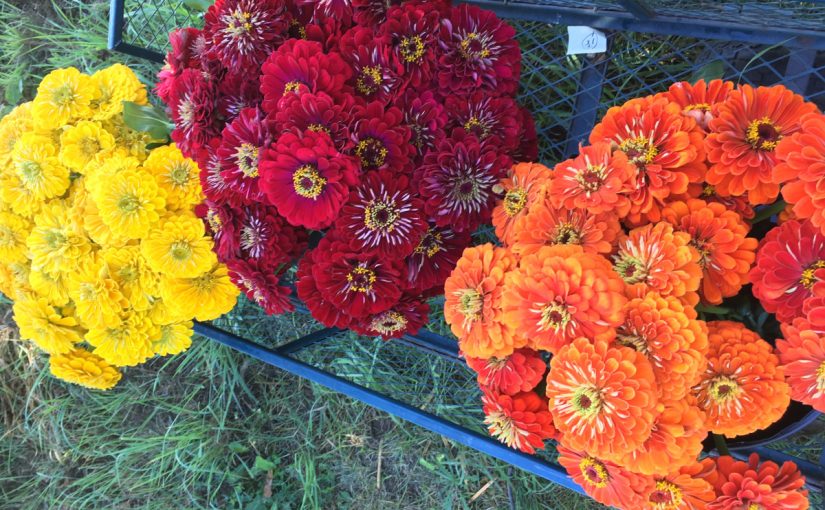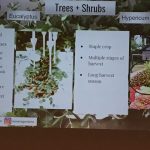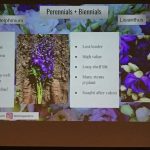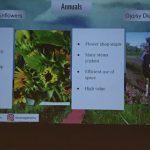WELCOME SESSION
Saturday morning started out early at 7:30AM in Corvallis, OR with some breakfast and some networking. As a lot of the sessions overlapped and all looked really interesting and relevant (and because the conference was only $50 total), I forced my partner Tony to attend with me so we could collectively attend more of the breakout sessions and thus gain more of the knowledge. It was definitely good he came not only because of all of the sessions he attended but also because he was able to my future bosses Denis and Diane of Jello Mold. They were there because Diane was giving a talk during the Cash Flow session on crop insurance (which Tony attended). It was good to chat with them and have them meet Tony.
The official welcome session started at 8:50AM with a recognition that the conference was totally sold out, all 1000 seats filled. I also liked that they addressed why the conference cost was so low. As most attendees are just starting out with farming and considered “socially disadvantaged” or “low income,” the organizers of the conference put most of the cost on the sponsors. They really don’t want to gouge those that are just starting out on their journey or are actively working on the slow, local, sustainable food movement.
The keynote speaker of the welcome session was Javier Zamora of JSM Organics located in Aromas, CA. Originally from Mexico, Zamora started with an acre and a half in 2012 but now has 120 acres of fruits/vegetables and 200+ acres of pastureland for cattle. My biggest take-away was that, to be successful you have to diversify and you can’t do it alone. He really stressed having a really solid crew that works well together is derived from paying people what they are worth ($13-$19/hour). To do this, he said he must educate his customers so they know why his produce is priced the way is it and the real cost of their food. He talked about how multifaceted sustainability is. Businesses must focus on economic sustainability and social sustainability as well as environmental sustainability. Without economic sustainability (cash flow) and social sustainability (paying your employees what they’re worth), you won’t be in business long enough to actually be able to achieve environmental sustainability.
SESSION ONE: Profitable Flowers of the PNW
This is the fourth year the OSU Small Farms Conference has had a cut flower track at the conference, which is really cool because there are a ton of people growing or wanting to grow cut flowers in the PNW as it is a really good environment to grow a wide variety of flowers. Three flower farms were showcased during this session.

Source: When In Tri-Cities
The first farm was My Garden Overfloweth, located in Paterson, WA and was a mother-daughter duo doing most of the work. This will be their sixth season growing cut flowers; the mother and her husband farmed a very large swath of land (growing asparagus and potatoes and raising cattle and hay) for 39 years before he retired and she took over two acres near the house for her flowers. They are technically located in the desert (zone 7A) and thus water is their biggest worry (although not too big of a worry as their water rights access the Columbia River). They also are 30 miles from the closest town, so access to markets can also be a challenge.
In terms of avenues of revenue, they do weddings (DIY, a la carte, and full service), wholesale (someone picks them up from their farm and takes them to Portland), direct to florists (weekly run in a 200 mile radius), and one weekly farmers market in the grow season (make custom bouquets on site for market-goers). They also host two on-farm events (a Spring Fling and a Fall Fling) that allows their customers to visit the farm. They also just built a farm store that allows them to sell bouquets and other local wares on-site, as well as host wreath-making, succulent terrarium-making, and hanging basket design classes to name a few.
Their top five best selling crops are lisianthus, eucalyptus, roses, dahlias, and heirloom pumpkins.
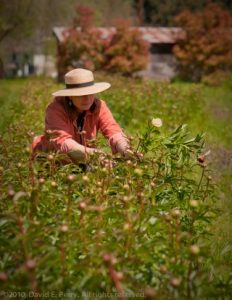
Photo: Le Mera Garden
The second farm was Le Mera Gardens, located in Talent, OR and also a mother-daughter duo. Originally started 25 years ago, Joan Thorndike started on 1 1/3 acre but is now on 12 acres. Through a partnership with Fry Family Farm also located in that area, they sell their flowers wholesale, to DIY brides at the Fry Family Farm store, and at 5 local farmers markets. The daughter uses her mother’s flowers in her own floral design business (JackLilly Floral) to make floral design products as well as full service weddings.
As Portland is located 4 and a half hours away and San Francisco is 5 hours away, is was absolutely crucial that they be able to sell locally, which they do! In terms of success, the key factors for them are: recognize beneficial partnerships, do what you love, know your market (i.e. what will sell, what won’t), educate your market, and produce a consistently excellent product (study your crops: what will make each one last as long as possible?). In terms of what makes a good crop, some things they said to consider: grows well on your land, suits your market, has multiple useful stages, long growing season, and doesn’t ship well (people can’t get it from anywhere else).
In terms of their successful crops, some of them include eucalyptus, hypericum, delphinium, lisianthus, sunflowers, and gypsy dianthus. Another interesting tidbit shared was to plant color varieties according to season as people want/expect to see certain colors in spring versus summer versus fall.
The third farm was Field to Heart, located in Snohomish, WA. Run by Danielle Swan with the help of her husband Valiant Poole, they started on 1/8 of an acre at first from their midwife who owns and operates Raising Cane Ranch (a cane berry and highland cattle farm). On that 1/8 of an acre, they started a U-Cut flower patch. The goal of this was to get people out on a farm and experiencing local flowers (something physical/tangible). To do this, the immediately made a killer entryway to ensure people felt welcomed and invited into their U-Cut space. This is now their fifth season growing flowers.
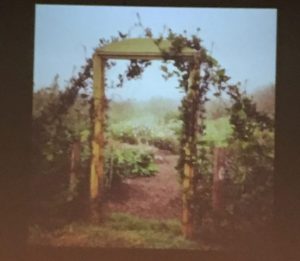
Photo: Allie Kuppenbender
Their biggest problems thus far has been too much water/flooding. Being located at the bottom of a river valley and about 8 feet elevation above sea level, they flood pretty much every winter.
They now have two locations and are growing one patch for U-Cut and the other patch for wholesale (Seattle Wholesale Growers Market Co-Op!!!) as well as DIY brides, a bouquet CSA, edible flowers for restaurants in Seattle, and for wreath parties/flower socials. Two crops they were incredibly excited about this past year were Chrysanthemums and Marigolds.
SESSION TWO: Marketing & Selling Specialty Cut Flowers
This session showcased two farms that have two very different but successful marketing strategies. Both are located in desert regions outside of the PNW.
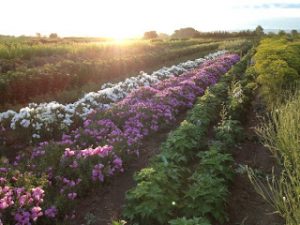
Photo: Bindweed Farm
The first farm was Bindweed Farm, located in Blackfoot, ID, located in between Sun Valley, ID and Jackson Hole, WY. Owned by couple Ralph Thurston and Jerriann Sabin, they have been in business for 25 years. The really unique thing about their location and market is that, as they are in the desert there really isn’t anyone else growing flowers in their area but these two towns have a lot of high-end resorts and vacation destinations. Their grow season is March through September, but their selling season is primarily Memorial Day to Labor Day and really 50% of their sales occur in July and August. They do have some season extension via high tunnels, with tulips and other bulbs for Easter and Mother’s Day. They grow over 90 varieties, focusing mainly on unique things and things that don’t ship well. They sell almost exclusively directly to florists, primarily for destination weddings and weekly resort floral arrangements.
In terms of things to focus on, Jerriann broke down the core components to success for her. These were pricing (make it easy for the customer; focus on shopping rather than buying), communication (two different ways of getting product lists out to accommodate various commutation styles of customers, website archives past season’s crops), and service (24/7 access, courier delivery service on days they don’t deliver). All of these combined with their quality blooms ensure a great product and service, meaning they can charge top dollar because customers know they can always count on them.

Photo: Whipstone Farm
The second farm was Whipstone Farm, located in Paulden, AZ. It was really funny that this was the showcased farm in this session as they were also showcased in the Floret Online Workshop’s Module One as a model flower farm business. Owned by Corey and Shanti Rade, Whipstone started 20 years ago on 6 acres as a small vegetable farm. Over the year, they expanded to 18 acres at two different sites. About 10 years ago, Shanti started experimenting with flowers and they’ve been a part of their business ever since. She grows on roughly three acres and has all sorts of varieties of flower crops going. They sell the flowers at three farmers markets, as bouquet add-ons to their vegetable CSA, weddings (mostly DIY, but some full service), and some wholesale to restaurants/florists. As they are really the only ones growing flowers in their area, there is zero competition at the farmers markets in terms of flowers. There is also really interesting crossover being a vegetable and flower farm. Some of this includes edible flowers, bolted/flowering herbs, and vegetable/fruit vines/branches in arrangements.
SESSION THREE: Accessing & Preserving Farm Land, Models from Oregon and Around the US
This session was predominantly about land trusts and conservation easements. The speakers were from two different land trusts, Greenbelt Land Trust (based in the lower Willamette River Valley) and PCC Land Trust (based in the Puget Sound area). A conservation easement basically is a stipulation on the land that limits some of the rights of the land owner (i.e. development rights, subdividing the lot, buffer zones, habitat restoration, etc.) to ensure the land remains agricultural land. While this lowers the value of the land, that difference is paid for by a land trust (generally a non-profit or governmental entity). Conservation easements allow young farmers to access land because it makes the cost of purchasing land a lot lower.
These two speakers went over the basics of land trusts and conservation easements, as well as why they are so important in keeping agricultural land in agriculture. According to statistics PCC Land Trust shared with us, “in the last 4 years, the average price per acre of Washington farmland has increased by 47%, 71% of retiring farmers have not identified a successor, and some Washington counties have lost over 70% of its farmland since 1950.” They also gave examples of farmers they have worked with that put conservation easements on their land, which was probably to most helpful part of their presentation. It was kind of weird though that both of these land trust entities prioritized large farms (100+ acres) as this was a small farms conference.
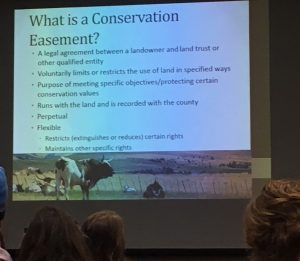
All in all, I had a really good time at OSU’s Small Farm Conference and learned a ton. Especially considering it was only $50 to attend, I really feel I got a lot of bang for my buck (the food for breakfast and lunch alone made it worthwhile). I definitely want to go back next year.
